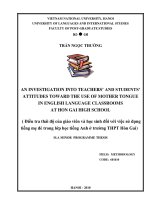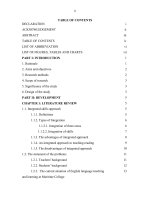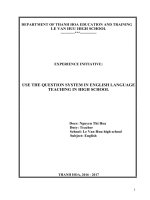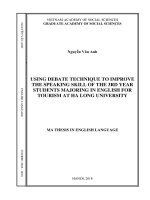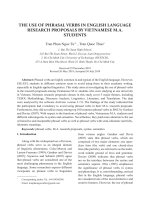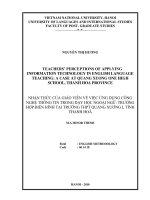The feasibility of integrated approach in English language teaching at Maritime College No.1, Haiphong = Tính khả thi của phương pháp tích hợp trong giản.PDF
Bạn đang xem bản rút gọn của tài liệu. Xem và tải ngay bản đầy đủ của tài liệu tại đây (493 KB, 16 trang )
VIETNAM NATIONAL UNIVERSITY, HANOI
UNIVERSITY OF LANGUAGES AND INTERNATIONAL STUDIES
FACULTY OF POSTGRADUATE STUDIES
NGUYỄN DUY LỢI
THE FEASIBILITY OF INTEGRATED APPROACH IN
ENGLISH LANGUAGE TEACHING AT MARITIME
COLLEGE No.1, HAI PHONG
(TNH KH THI CA PHƢƠNG PHP TCH HỢP TRONG GING
DY TING ANH TI TRƢNG CAO ĐNG HNG HI 1, HI
PHNG)
M.A. MINOR THESIS
Field: English Teaching Methodology
Code: 60 14 10
H NI, 2011
VIETNAM NATIONAL UNIVERSITY, HANOI
UNIVERSITY OF LANGUAGES AND INTERNATIONAL STUDIES
FACULTY OF POSTGRADUATE STUDIES
NGUYỄN DUY LỢI
THE FEASIBILITY OF INTEGRATED APPROACH IN
ENGLISH LANGUAGE TEACHING AT MARITIME
COLLEGE No.1, HAI PHONG
(TNH KH THI CA PHƢƠNG PHP TCH HỢP TRONG GING
DY TING ANH TI TRƢNG CAO ĐNG HNG HI 1, HI
PHNG)
M.A. MINOR THESIS
Field: English Teaching Methodology
Code: 60 14 10
Supervisor : Dr. Dƣơng Thị Nụ
H NI, 2011
iv
TABLE OF CONTENTS
DECLARATION
i
ACKNOWLEDGEMENT
ii
ABSTRACT
iii
TABLE OF CONTENTS
iv
LIST OF ABBREVIATION
vi
LIST OF FIGURES, TABLES AND CHARTS
vii
PART I: INTRODUCTION
1
1. Rationale
1
2. Aims and objectives
2
3. Research methods
2
4. Scope of research
3
5. Significance of the study
3
6. Design of the study
3
PART II: DEVELOPMENT
5
CHAPTER 1: LITERATURE REVIEW
5
1.1. Integrated-skills approach
5
1.1.1. Definitions
5
1.1.2. Types of Integration
6
1.1.2.1. Integration of three areas
6
1.1.2.2. Integration of skills
7
1.1.3. The advantages of integrated approach
8
1.1.4. An integrated approach to teaching reading
9
1.1.5. The disadvantages of integrated approach
10
1.2. The statement of the problems
11
1.2.1. Teachers' background
11
1.2.2. Students’ background
12
1.2.3. The current situation of English language teaching
and learning at Maritime College
13
v
1.2.3.1. The teaching situation
13
1.2.3.2. The learning situation
13
1.3. Summary
13
CHAPTER 2: RESEARCH METHODOLOGY
14
2. 1. Methodology
14
2.1.1. Research questions
14
2.1.2. The participants
14
2.1.3. The instruments
14
2.1.3.1. Survey questionnaires
14
2.1.3.2. Class observation
15
2.1.3.3. Informal interview
16
2.2. Data analysis
17
2.3. Summary
18
CHAPTER 3: FINDINGS AND DISCUSSIONS
19
3.1. Teacher survey questionnaire
19
3.1.1. Teachers’ perceptions of feasibility of
Integration of skills to Reading at Maritime College
19
3.1.2. Advantages of Integrated Approach
22
3.1.3. Disadvantages of Integrated Approach
23
3.2. Class observation
28
3.3. Informal interview
28
3.4. Major findings
29
3.5. Recommendations and suggestions
30
3.6. Sample lesson plans with integrated approach
32
PART III: CONCLUSION
38
1. Conclusions
38
2. Implications
38
3. Limitations
39
REFERENCES
43
APPENDICES
I
1
PART I: INTRODUCTION
1. Rationale
In this paper I would like to give an overview of maritime English
teaching at the Maritime College No. 1, Hai Phong, addressing some
advantages and disadvantages of integration of four skills to Reading and
providing suggestions on how to improve the communicative skills in
maritime English teaching at Maritime College.
For all these reasons above, a thesis named: “THE FEASIBILITY OF
AN INTEGRATED APPROACH IN ENGLISH LANGUAGE TEACHING
AT MARITIME COLLEGE No. 1, HAI PHONG” has been fostered and
conducted.
2. Aims and objectives
The study is an attempt to meet two aims. It not only points to the
advantages and disadvantages of integrated-skills teaching at MC but also to
provide guidance and suggestions in applying the method with the purpose of
teaching improvement.
3. Research methods
In this section, the author provided the description of the instruments for
collecting data that were used and also highlighted the strengths and weakness
of the research methods chosen.
4. Scope of the study
As mentioned in the research’s title, the research is aiming at an
investigation on the suitability of integrated-skills method at MC.
5. Significance of the study
Being one of two colleges in Vietnam specializing in Maritime industry,
MC has played a very important role in providing Maritime English lectures
and labour forces for the nation
6. Design of the study
PART I: INTRODUCTION provides the basic information such as the
aims, the scope, and significance of the study.
2
PART II: DEVELOPMENT contains of 3 chapters.
Chapter 1: Literature Review justifies the literature on integrated teaching
approach, categories of integration, the advantages and disadvantages of this
method and especially the statement of the problems whose background of
teachers and students are given clearly with the application of this method at
the school.
Chapter 2: Research Methodology focus on the methodology employed in this
study, including the methodology, the participants, the instruments for data
collection.
Chapter 3: Findings and Discussions are reported.
PART III: CONCLUSION AND IMPLICATIONS presents a review of the
research and the recommendations for the improvement of the material with
selected suggestions for further research.
PART II: DEVELOPMENT
CHAPTER 1: LITERATURE REVIEW
The process of the literature review involves the researcher in exploring
the literature to establish the status quo, formulate a problem or research
enquiry, define the value of pursuing the line of enquiry established, and
compared the findings and ideas with his or her own (Andresen 1997, adapted
from Bruce 1994).
1.1. Integrated teaching approach
1.1.1. Definitions
The philosophy of integrated skills approach is based on the concept that
in natural, day-to-day experience, oral and written languages are not kept
separate and isolated from one another. Instead, they often occur together,
integrated in specific communication events (Peregoy & Boyle, 2001).
Cunningsworth states that “In the actual language use, one skill is rarely
used in isolation Numerous communicative situations in real life involve
integrating two or more of the four skills. The user of the language exercises
3
his abilities in two or more skills, either simultaneously or in close succession.”
(1984, p.46).
Similarly, Hersan points out that “nowadays, communication is the
major aim for learning a foreign language. In daily life, these skills are seen in
integration, for example, after reading a letter, usually an answer to this letter is
written. So in the classroom the activities should be taught in integration in
order to arrive at ease in communication.” (1998, p. 22).
1.2.2. Types of Integration
The concepts of integration are separated into two as in the chart below:
Figure 1: Classification of integration (Meltem Huri, 2010)
1.2.2.1. Integration of three areas
Grammatical Integration
Most of the course books apply this type of integration. There is no
topical/thematic unity among the skills activities, but they reinforce the same
grammatical item. Therefore, one/a unit of the course book is completely
centred on items such as tenses, articles, adverbial forms and so on with its
skills activities.
This type of integrated unit in a book can be confused with a wholly
grammar-based unit. The difference between a wholly grammatical unit and a
grammatically integrated unit is that while the former one ignores the
communicative value of language, the second one recognizes it by using
Integration of 3 areas
Integration of skills
INTEGRATION
Grammar
Language functions
Topics/themes
Reading
Writing
Listening
Speaking
4
different skills communicatively, focusing on a grammatical item.
Skills activities might be presented in different topics and settings but
focusing on only one grammatical item and without logical links among them.
Functional Integration
It focuses on gathering and using skills in an organization around one
social functions of language.
Thematic/Topical Integration
In this type of integration, skills are practiced in conjunction with each
other around a topic in the way they are integrated in real life. If there is a
context, and skills activities are not isolated from this context, there thought to
be a topical unity among activities. Whenever the writers have examined the
course books for the integration of skills, this is the only type of integration the
course books seem to cover under the title of “Integration of Four Skills”.
1.2.2.2. Integration of skills
The integration of skills is a combination of four language skills
including Listening, Speaking, Writing and Reading is the most important task
for teachers.
1.2.3. The advantages of integrated approach
To summarize, using an integrated skills approach enables students to
develop their ability in the use of two or more of the four skills within real
context and in a communicative framework.
1.2.4. An integrated approach to teaching reading
1. When analyzed, there is a large overlap among the component skills of the
four skills: listening, speaking, reading and writing.
2. In real-life communication, there is a frequent alternation between receptive
and productive activities.
3. People have differences in their ability to learn through the ear, the eye and
muscular movement.
4. If something is taken in through more than one channel, it is more likely to
be learned well.
5
5. Students even of the same age, sex and cultural background are often not
interested in the same thing (1981, p. 93).
1.2.5. The disadvantages of integrated approach
In conclusion, the teacher should incorporate opportunities throughout
the learning process for students to develop their own language skills by
responding verbally as they read, write, and learn in English .
1.3. The statement of the problems
1.3.1. Teachers' background
The teaching staffs have been known to be the key to success of
traditional teaching and learning at Maritime College No.1. At the college,
there are 23 teachers of English. Fourteen out of 23 had the full-time training in
English teaching course at the University.
1.3.2. Students' background
Students are selected through an entrance examination for college level.
As for other levels such as secondary and vocational students, these procedures
are determined via documents assessments.
1.3.2. The current situation of English language teaching and learning at
Maritime College
1.3.2.1.1. The teaching situation
College students have to learn five terms out of six terms within their
courses whereas the others have to learn three terms out of four. There are two
types of course book used at Maritime College.
1.3.2.2. The learning situation
Students study at three main departments at Maritime College. These are
Engine Department, Navigation Department, and Electro-Mechanical
Department.
1.4. Summary
Chapter one has presented the definition, roles of integration of four
skills teaching method as well as the advantages and disadvantages that need to
be taken to be account
6
CHAPTER 2: RESEARCH METHODOLOGY
2.1. Methodology
This Chapter describes how to collect information using a set of tools
including survey questionnaire, class observation, and informal interviews.
2.1.1. Research questions
To fulfil the aims mentioned above, the research addresses the following
questions:
What are the advantages and disadvantages of using integrated approach
at Maritime College No.1, Hai Phong?
2.1.2. The participants
The study investigates the feasibility of applying integrated approach of
twenty three (23) teachers in Maritime College No. 1, Haiphong.
2.1.3. The instruments
A combination of different methods is used to collect various sources of
data.
2. 1.3.1. Survey questionnaires
Interviewing can be a complicated business as far as finding mutually
convenient times is concerned.
The researcher made use a set of survey questionnaires including closed
and open-ended questions to cover all belief of teachers and suggestions
serving for the improvement of the current learning and teaching situation.
2. 1.3.2. Classroom observation
2. 1.3.3. Informal interviews
Hopkins (cited in McDonough & McDonoug, 1997) lists three
applications of interviews in classroom research.
2.2. Data analysis
The research is expected to achieve the main following contents:
+ Teachers’ perceptions of feasibility of Integration of skills to Reading at
Maritime College;
+ Advantages of Integrated Approach;
7
+ Disadvantages of Integrated Approach;
+ Feasibility of Integrated Approach, Recommendations and suggestions.
2.4. Summary
A discussion of data collection instruments have been conducted in this
chapter. It also described the participants, the methodology used and data
analysis.
CHAPTER 3: FINDINGS AND DISCUSSIONS
In the closing chapter, the author integrates and summarizes briefly all
of the preceding chapters.
3.1. Teacher survey questionnaire
The teacher survey questionnaires were completely fulfilled by 22
teachers out of 23 teachers who have been teaching English at Maritime
College.
3.1.1. Teachers’ perceptions of feasibility of Integration of skills to
Reading at Maritime College
These figures show that the integrated approach has been popular and similar
with MC teachers. Specifically, what are their clear ideas on the integration
method would be discovered by the following questions in the Questionnaires
as given.
Chart 1: Teachers’ current language teaching approaches at MC
Chart 2: Appropriateness of the integrated Approaches
According to the Figure, 80% of teachers agreed that integrated
approach is appropriate to apply at Maritime College No. 1 in current situation.
The teachers themselves did not know how to apply the methods effectively.
Chart 3: Priority in Language Teaching
This method required students to be more active as they had to enrich
the prior knowledge before they came to class.
8
Chart 4: Definition of Integrated Approaches
In general, the author and almost teachers at MC have the same belief of
the integration method aiming to study with perspectives of combination of
four language skills in a unit lesson.
3.1.2. Advantages of Integrated Approach
There were, according to the Table 1, two significant trends on teachers'
ideas on the advantages of integrated approach can bring about in the belief of
teachers.
Table 1: Advantages of Integrated Approach
No
Advantages
(%)
1
Help students develop four language skills
75%
2
Students are flexible to cope with various communicative situations
in real life context
80%
3
Interaction between teachers and students reaches at high level of
effectiveness
40%
4
Exposes students to authentic language and challenges them to
interact naturally in the language
45%
5
Be able to assess the overall language competence of students
85%
6
Make the lessons less boring by applying various skills in a lesson
90%
7
Be flexible for teachers to concentrate on the areas he/she wants
50%
8
Teachers feel free to provide more practical experience and learning
materials to support the lesson
90%
9
Be easy for both teachers and learners and within the capabilities of
all teachers
55%
10
Teachers are flexible to create suitable learning
environment/atmosphere.
80%
11
Others:
0%
9
3.1.3. Disadvantages of Integrated Approach
Regarding the disadvantages of the integration method, there were some
difficulties when integration method is applied.
Table 2: Disadvantages of integrated Approach
No
Disadvantages
(%)
1
Both teachers and students have to make great effort for preparation
if integration of teaching methods is applied
50%
2
It is demanding for the teachers because the teachers are required to
master high level of language understanding and practical experience
90%
3
It is not suitable to the newly-graduated teachers but the experienced
teachers
80%
4
It is time-consuming at class. The teachers do not have enough time
to do that.
40%
5
It makes students stressful and anxious to learn English
10%
6
It is not important and suitable at Maritime College because the
students need to learn Maritime English Vocabulary only
20%
7
The textbook is out-of-date, thus it is difficult to involve students in
learning by the integrated approach
15%
8
The students may be discouraged to get involved because of no
mother-tongue equivalents for Maritime technical terms
10%
9
Not enough teaching aids (such as projector, camera, speakers, etc),
thus the teachers fail to apply integrated methods at Maritime
College
80%
10
Due to different level of English proficiency and big number of
students in a class, the teachers may fail to complete the lesson if an
integrated method is applied.
95%
11
Others
0%
10
Chart 5: Integrated Approaches implementation
The current difficulty for these teachers is that they needed time to
prepare as well as get their students ready for new things.
Chart 6: Suitability and applicability of Integrated Approaches in
Language teaching at MC
In the extent to which the integrated method is applied is illustrated in
chart 7
Chart 7: Fluency of Integrated Approaches applications
Table 3: Recommendations for the application of integrated approach
No
Recommendations for the application of Integrated Approaches
(%)
1
In-service training of integrated approach should be provided for
teachers at Maritime College.
70%
2
The teaching materials and facilities should be improved to support
Integrated Approach
100%
3
The number of students in each class should be reduced to make it
easier to adopt Integrated Approach
80%
4
Tests should include not only grammar points, but also other
language skills such as listening and speaking, writing.
60%
5
Others:
0%
3.2. Class observation
3.3. Informal interview
The informal interviews were carried out with three participants who are
representatives from different groups of age and experience. The first, second
and third interviewees are in the range of 3 years, 8 years and 12 years of
teaching experiences.
3.4. Major findings
11
1. The first priority of English language teaching is enhancing
communication skills, thus, as application of the integrated
approach, it help students flexible to cope with various
communicative situations in real life context.
2. Secondly, this approach can improve the learning atmosphere
3. One of other advantages of IA is that during application of IA,
authentic materials are easily supported to different lesson and
the teachers feel free to provide more practical experience to
students
The following disadvantages of the method have been discovered in
this study:
1. It is a fact that due to time constrains and big number of
students in a class, teachers may fail to complete the lesson.
2. On one side, the integration method has created favourable
conditions
3. Teachers always complained that they have been in charge of
many classes thus they have no time for preparation and
implementation.
3.5. Recommendations and suggestions
* Learn more about the various ways to integrate language skills in the
classroom.
* Reflect on their current approach and evaluate the extent to which the skills
are integrated.
* Choose instructional materials, textbooks, and technologies that promote the
integration of listening, reading, speaking, and writing, as well as the associated
skills of syntax, vocabulary, and so on.
* Even if a given course is labeled according to just one skill, remember that it
is possible to integrate the other language skills through appropriate tasks.
* Teach language learning strategies and emphasize that a given strategy can
often enhance performance in multiple skills.
12
PART III: CONCLUSIONS
1. Conclusions
Skills are the building blocks of language learning process. They are
effective elements of teaching and learning process.
2. Implications
In conclusion, the findings of this study has suggested that despite a
number of shortcomings, the integration methods can still make effective
teaching and learning outcomes for students in general and the students in the
current situation at MC.
3. Limitations
The issues addressed in this study involved mainly teachers’ opinions
through questionnaires, observation and interviews.
